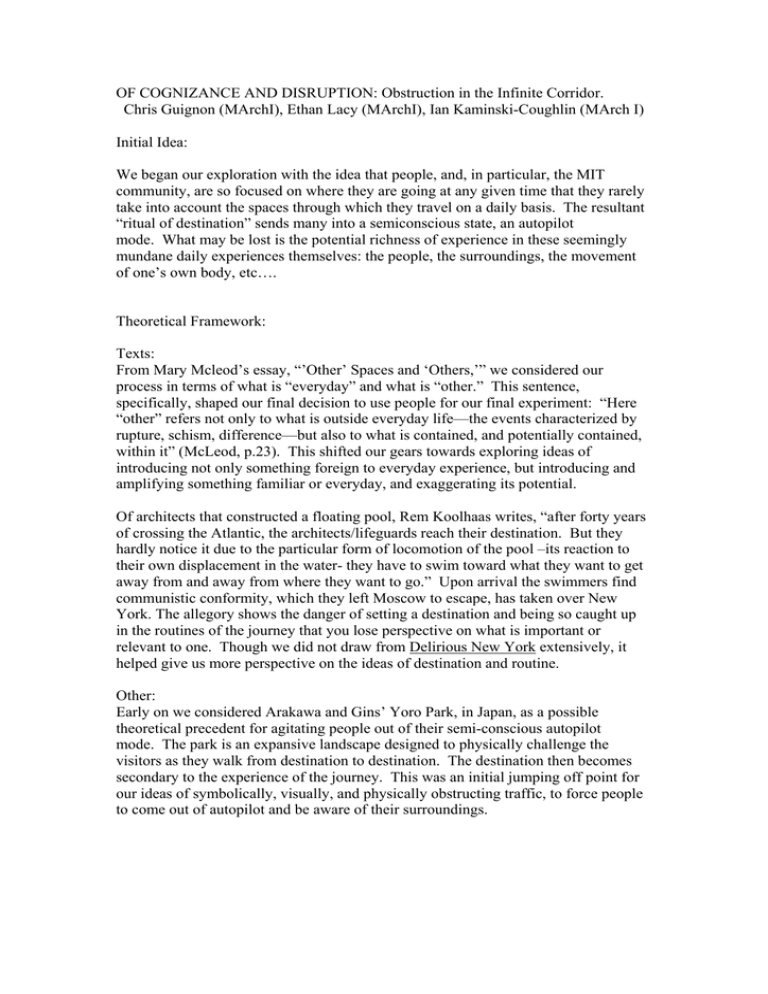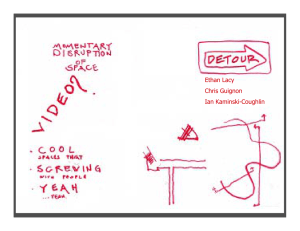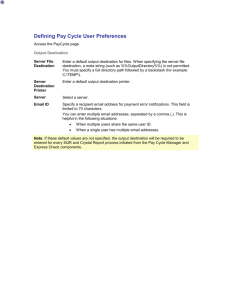OF COGNIZANCE AND DISRUPTION: Obstruction in the Infinite Corridor.
advertisement

OF COGNIZANCE AND DISRUPTION: Obstruction in the Infinite Corridor. Chris Guignon (MArchI), Ethan Lacy (MArchI), Ian Kaminski-Coughlin (MArch I) Initial Idea: We began our exploration with the idea that people, and, in particular, the MIT community, are so focused on where they are going at any given time that they rarely take into account the spaces through which they travel on a daily basis. The resultant “ritual of destination” sends many into a semiconscious state, an autopilot mode. What may be lost is the potential richness of experience in these seemingly mundane daily experiences themselves: the people, the surroundings, the movement of one’s own body, etc…. Theoretical Framework: Texts: From Mary Mcleod’s essay, “’Other’ Spaces and ‘Others,’” we considered our process in terms of what is “everyday” and what is “other.” This sentence, specifically, shaped our final decision to use people for our final experiment: “Here “other” refers not only to what is outside everyday life—the events characterized by rupture, schism, difference—but also to what is contained, and potentially contained, within it” (McLeod, p.23). This shifted our gears towards exploring ideas of introducing not only something foreign to everyday experience, but introducing and amplifying something familiar or everyday, and exaggerating its potential. Of architects that constructed a floating pool, Rem Koolhaas writes, “after forty years of crossing the Atlantic, the architects/lifeguards reach their destination. But they hardly notice it due to the particular form of locomotion of the pool –its reaction to their own displacement in the water- they have to swim toward what they want to get away from and away from where they want to go.” Upon arrival the swimmers find communistic conformity, which they left Moscow to escape, has taken over New York. The allegory shows the danger of setting a destination and being so caught up in the routines of the journey that you lose perspective on what is important or relevant to one. Though we did not draw from Delirious New York extensively, it helped give us more perspective on the ideas of destination and routine. Other: Early on we considered Arakawa and Gins’ Yoro Park, in Japan, as a possible theoretical precedent for agitating people out of their semi-conscious autopilot mode. The park is an expansive landscape designed to physically challenge the visitors as they walk from destination to destination. The destination then becomes secondary to the experience of the journey. This was an initial jumping off point for our ideas of symbolically, visually, and physically obstructing traffic, to force people to come out of autopilot and be aware of their surroundings. OF COGNIZANCE AND DISRUPTION: Obstruction in the Infinite Corridor. Chris Guignon (MArchI), Ethan Lacy (MArchI), Ian Kaminski-Coughlin (MArch I) Process: We began with the idea of the detour. By setting up detour signs in the infinite corridor, we hoped that we could first obstruct, then redirect, people’s journeys to an unfamiliar place. Knocked off of their familiar path, they would be forced to be more conscious of their new, less familiar surroundings. At its best, the detour could provide an unexpected pleasant trip or a new discovery. At its worst, the detour could act as an agitation. Either way, the subject would be knocked out of autopilot for a moment or for the duration of their trip. The criticism was that the familiarity of the sign would do little more than awaken someone from their semiconscious state only long enough to follow the arrow on the sign, redirect their position, and fall back into autopilot. The experiment itself was only mildly successful in redirecting people’s paths, and most people chose to ignore the detour signs, defaulting instead to their routine familiarity with the structure of the infinite corridor. We then focused on creating a more involved obstruction – one that would force people to be aware of their speed of journey by slowing down or obstructing their path, and perhaps more importantly, to create an opportunity for human interaction. Doris Sommer’s workshop presentation involving the use of intervention in situations to prevent a tragic outcome allowed us to rethink who we were obstructing (MIT students), when we were obstructing them (two weeks before finals), as well as the idea of MIT students’ paucity of human contact in general. By using people to obstruct the flow in the infinite corridor, we responded to this idea of obstruction as intervention by encouraging our obstructers to actively engage conversation with the obstructees. From Gustavo Artigas’ presentation of participatory art we became aware that by using people as obstructions, the experience we were creating was three-fold. Those being obstructed had one experience, and those obstructing had another. In addition to this, as traffic slowed to a halt, and the line between who was obstructing and who was being obstructed became blurred. Thus, obstructees become unintentional obstructers. At this point it is most clear that the experience of the “ritual of destination” has broken for a moment as people are forced to slow down, confront each other, and negotiate passage. Texts: McLeod, Mary. “’Other’ Spaces and ‘Others’” pp.15-28 The Sex of Architecture / editors, Diana Agrest, Patricia Conway, Leslie Kanes Weisman ; [contributors], Diana Agrest ... [et al.]. New York : Harry N. Abrams, 1996. Koolhaas, Rem. “The Story of the Pool” pp.307-311 Delirious New York. Rem Koolhaas. New York: Monticelli Press, 1994.





